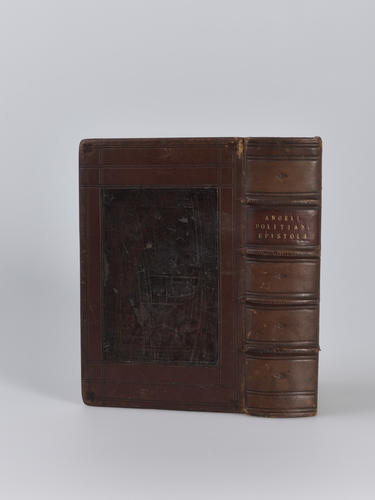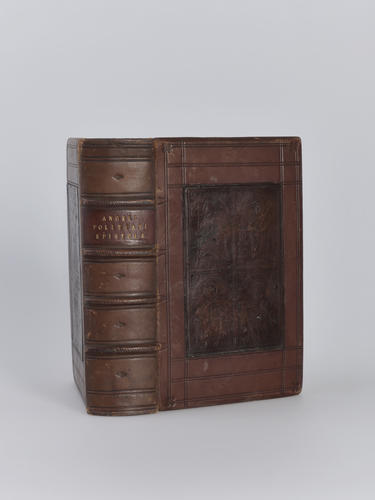Letters of Angelo Poliziano 1522
16.5 x 11.3 x 4.5 cm (book measurement (conservation)) | RCIN 1081338

Angelo Poliziano (1454–1494)
Angeli Politiani, et aliorum virorum illustrium, epistolarum libri xii 1522

Angelo Poliziano (1454–1494)
Angeli Politiani, et aliorum virorum illustrium, epistolarum libri xii 1522

Angelo Poliziano (1454–1494)
Angeli Politiani, et aliorum virorum illustrium, epistolarum libri xii 1522




-
Politian (Angelo Ambrogini, known as Politian or Poliziano) was one of the foremost Italian humanist scholars of the fifteenth century. Educated in both Latin and Greek from an early age, he was taken up by Lorenzo de’ Medici (1449-92) and made tutor to his children. He was noted for his poetry in both Latin and Italian, and his classical scholarship was in the best humanist tradition of textual purity, which led him always to seek out the earliest manuscripts in the original language that were available to him. His letters frequently followed the classical model of such authors as Cicero; they were not only private correspondence, but letters intended to be read by a more public audience, and designed to demonstrate his erudition and eloquence. Politian was in the process of preparing the corpus of his letters for publication when he died in 1494; the first edition appeared posthumously, published by Aldus Manutius in Venice in 1498, followed by later editions, based on Aldus’s own, from other printing houses both inside and outside Italy as late as the mid-seventeenth century. Erasmus was one of Politian’s early non-Italian readers, and derived several of his 'adagia' (or adages) from the letters to add to his collection (at the time of his death he had accumulated over 4,000 of them).
Holbein’s design for the title page of Politian’s letters was first made for a 1520 edition of the 'New Testament', edited by Erasmus and published by Andreas Cratander (active 1518-36). Cratander was originally from Strasbourg, and started in Basel as a proofreader for the printer Adam Petri (1454-1527), but later set up as a printer of humanist and classical texts, and some of the early works of Martin Luther. The woodblock was probably cut by Hans Herman, a German block cutter active in Basel from about 1516. Holbein’s design features two children flanking an old man in the centre top, and two children and two dolphins flanking Cratander’s printer’s mark - a naked woman with streaming hair set on a shield, to represent 'Occasio' or Opportunity. The vertical frame was made out of architectural features, with further figures on the central brackets: an animal on the left and a satyr playing the bagpipes on the right.
Catalogue entry adapted from The Northern Renaissance. Dürer to Holbein, London 2011.
Binding information
Contemporary binding in dark brown calf, both sides re-backed onto a restored lighter brown calf and spine. Blind-tooling throughout. Contemporary sections of binding measure only 7cm x 10.5cm on the right side, and 7.2cm x 10.6 cm on the left. Though these sections may have been part of the book’s original binding, it is also possible that they were re-used from another volume.
Right side blocked in blind with vertical panel stamp divided into quadrants, each containing a figure of a saint. The saints are, from left to right, top to bottom: St Nicholas (? holding a cruciform staff and book); St Barbara (holding a palm leaf and beside her tower); St Catherine (holding a sword in the left hand, book in her right, and spiked wheel on the ground to her right); and St John the Evangelist (holding a chalice); the initials 'G’ ‘R' to either side of the figure of St John. Panel very similar to that used on RCIN 1053840 (Add B 3), though slightly smaller with different saints.
Left side blocked in blind with horizontal panel containing in the centre the arms of Henry VIII: lions rampant quartered with fleur-des-lis, supported by a griffon and hound and surmounted by a crown; sun and a moon and two shields bearing a cross to left and right of crown. Latin inscription around all four sides of panel, consisting of a combination of Psalms 17:1 and 21:2: Confitemini domino quoniam / bonus quoniam / in seculum mi[sericordi]a eius / deus meus respice. Panel very similar to that used on RCIN 1053840 (Add B 3), though slightly smaller with different Latin inscription.
On both sides, restored lighter brown calf blind-tooled with three double fillet borders and flower-head stamps in each of the four corners.
Spine in the same restored calf, divided into five compartments by raised bands, blind-tooled with cross-hatch design, with double fillet borders blind-tooled to either side and at the head and tail. Second compartment contains an additional piece of red leather, with the title gold-tooled: ‘ANGELI POLITIANI EPISTOLAE’; all other compartments blind-tooled with central diamond-shaped flower head.
Inside of both board blind-tooled with cross-hatch design.
RCIN 1053840 (Add B 3) is also tooled with a pair of panels, one armorial panel and one quartered with saints, and the initials 'G. R.' This suggests that both books were bound by the anonymous 'G. R.', bookbinder, who was working in the 1520s and 30s, possibly in London.There are four panels associated with the binder 'G. R.', two with saints in four compartments and two with the royal arms. As with RCIN 1053840, they were often paired (one saint panel and one armorial panel) on the same binding.Provenance
Historically believed to have been bound for Henry VIII. Previously owned by John Barkesdale, Thomas Willes and Samuel Clarke (active 1550-1600 but not yet identified); Rev. W.E. Buckley (1817-92); his sale, Sotheby's, London, 16-27 April 1894 (lot 3018), £1 8s; William Ridler, bookseller (active 1877-1904); acquired for the Royal Library by 1901. Bears the bookplate of Queen Victoria, used 1863-1901.
-
Creator(s)
(publisher)Acquirer(s)
-
Measurements
16.5 x 11.3 x 4.5 cm (book measurement (conservation))
19.0 x 5.5 cm (book in box)
16.5 x 4.5 cm (book measurement (inventory))
Markings
annotation: Underlining of text and notes in margins throughout in sixteenth-century hand, pen. [Throughout text]
Category
Alternative title(s)
Angeli Politiani, et aliorum virorum illustrium, epistolarum libri xii.
Place of Production
Basel [Switzerland]








